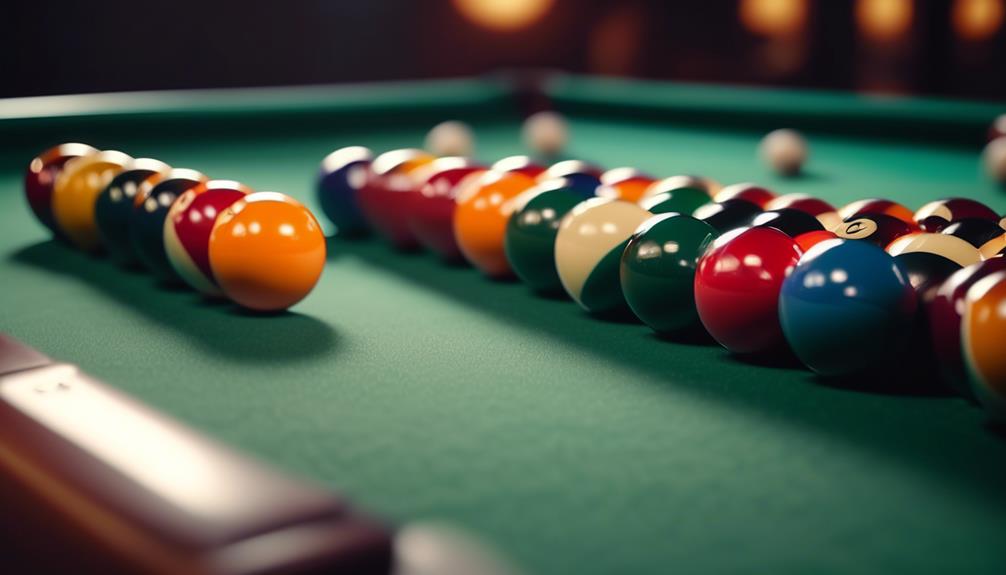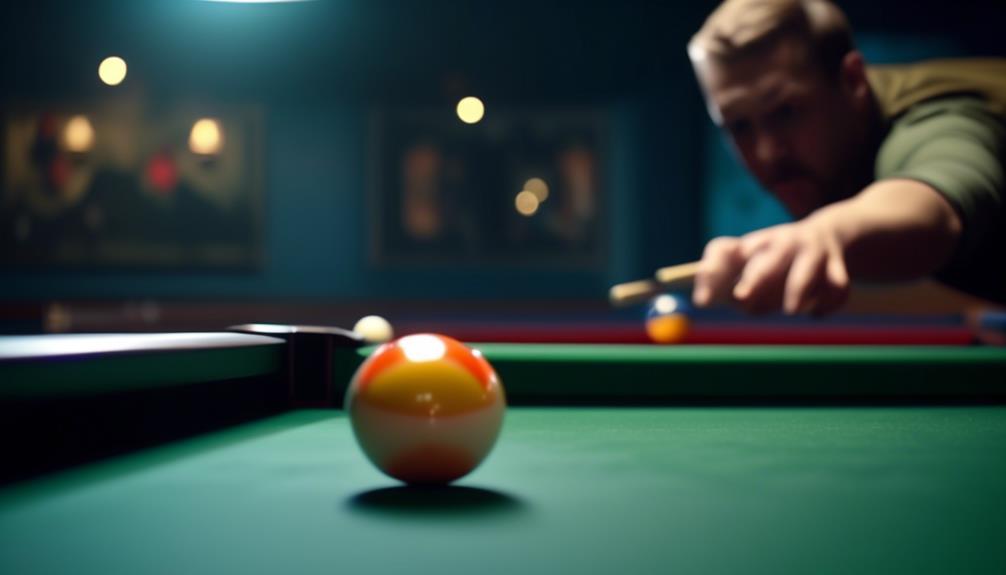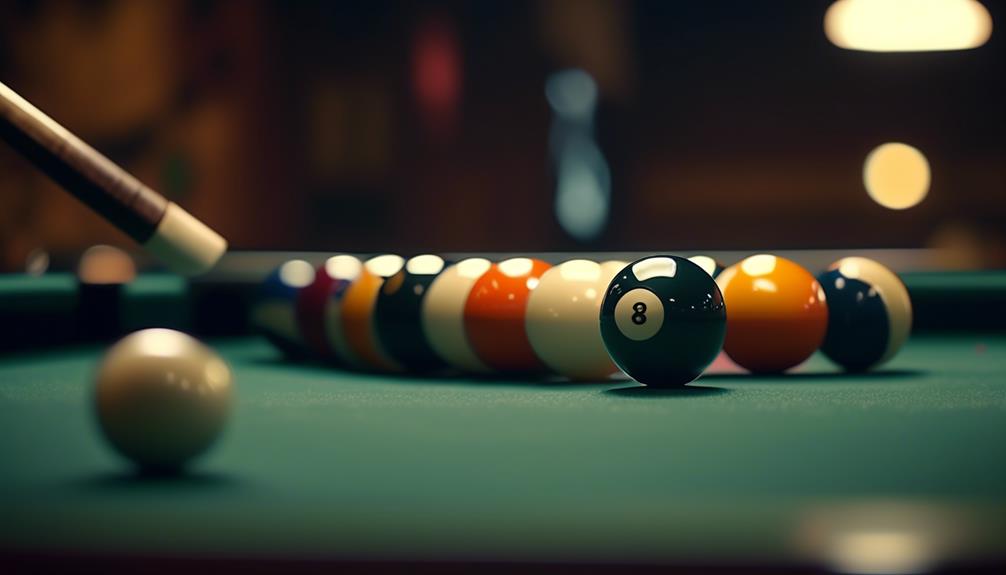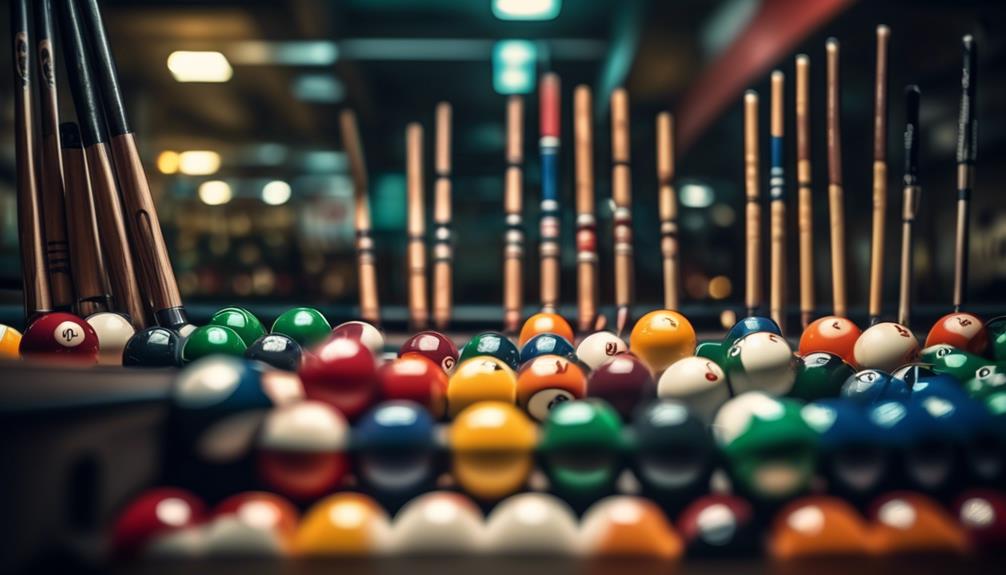How to Play 9 Ball Pool
This post contains affiliate links. As an Amazon Associate, we earn from qualifying purchases.
For those seeking to master the game of 9-ball pool, understanding the intricacies of the game is essential. From setting up the initial rack to executing advanced strategies, there are numerous elements that contribute to a player's success.
Whether you are a novice or an experienced player, delving into the rules, strategies, and tactics of 9-ball pool can significantly enhance your gameplay.
Key Takeaways
- The objective of 9-ball pool is to pocket the 9-ball using legal shots.
- Players must hit the lowest numbered ball and continue hitting the lowest numbered ball on the table.
- Adhering to the rules and avoiding fouls ensures fair and competitive gameplay.
- Strategic positioning of the cue ball and planning the sequence of shots are crucial for success in 9-ball pool.
Objective
The objective of 9 ball pool is for players to pocket the 9-ball using legal shots, following a numerical order and aiming to secure victory by legally pocketing the 9-ball.
To play, the first player must hit the lowest numbered ball and then continue hitting the lowest numbered ball on the table. If the lowest numbered ball is pocketed, the player continues to hit the next lowest numbered ball.
The game is won when a player pockets the 9-ball after hitting the lowest numbered ball on the table.
Players must place the cue ball anywhere behind the head string for the opening break shot.
Understanding the objective of hitting the lowest numbered balls in sequence is crucial to strategically plan and execute shots in 9 ball pool.
Racking and Breaking

When racking the balls in 9 ball pool, it is essential to use a diamond or triangular rack. Position the 1-ball at the top and the 9-ball in the middle of the third row, arranging the remaining balls as desired.
Breaking the rack requires the cue ball to be placed behind the head string. The aim is to hit the 1-ball and pocket at least one ball (except the 9-ball), or have four object balls hit a rail for a legal break.
These critical points will be further expounded upon in the following discussion of racking technique and breaking strategy.
Racking Technique
Optimizing the arrangement of the balls within the rack is crucial for achieving an effective racking technique in 9 ball pool. To ensure a proper racking technique, follow these steps:
- Place the 1-ball at the top of the rack over the foot spot.
- Position the 9-ball in the middle of the third row.
- Arrange the remaining balls as desired within the triangular rack.
When racking, ensure that the balls are tightly packed without any gaps to prevent movement during the break. Additionally, the lowest number ball should be at the apex of the rack to facilitate an effective break.
Breaking Strategy
In 9 ball pool, achieving a successful breaking strategy is integral to gaining an advantage in the game. When racking the balls, place the 1-ball at the top and the 9-ball in the middle of the third row.
During the break, aim to hit the 1-ball first and pocket any ball (except the 9-ball) or ensure that at least four object balls hit a rail for a legal break. It is essential to make first contact with the lowest numbered ball on the table. An illegal break requires a re-rack, allowing the other player to break.
After a legal break, the player can choose to push out, enabling them to shoot the cue ball into a new position. However, fouls such as scratching or failing to hit the lowest numbered ball first result in penalties.
Adhering to these breaking strategies is crucial for success in 9 ball pool.
Playing the Game
When playing 9 ball pool, it is crucial to understand the rules of the game, including the specific strategies involved in basic gameplay.
Additionally, players must be aware of common fouls to avoid, such as scratching, failing to hit the lowest numbered ball first, and pocketing balls during a push out.
Mastering these points will greatly enhance a player's ability to succeed in 9 ball pool.
Rules of 9 Ball
To play 9 Ball, it is crucial to adhere to the specific rules governing the game, ensuring fair and competitive gameplay. The Official Rules of 9 Ball include:
- Legal Shot: When hitting the cue ball, the player must hit the lowest-numbered object ball first or cause the cue ball or any numbered ball to contact a rail. Failure to do so results in a foul.
- Object of the Game: The primary objective is to pocket the 9-ball. A player gets this opportunity only after legally pocketing all the other object balls.
- Fouls and Penalties: Fouls, such as scratching the cue ball or not hitting the lowest-numbered ball first, result in the opponent getting a ball-in-hand and the player receiving penalties. Three consecutive fouls lead to an immediate loss.
Adhering to these rules ensures a challenging yet enjoyable 9 Ball pool game.
Basic Gameplay Strategies
Implementing effective basic gameplay strategies is essential for achieving success in 9 Ball pool. Players should aim to control the cue ball's position to set up better shots for the next ball.
Practice various shot types, including bank shots and combination shots, to expand your skills. Strategic planning is crucial, so study the layout of the numbered balls on the table to determine the best sequence for pocketing them.
Developing a consistent and accurate stroke is also vital for successful shot execution. Observing professional players can provide valuable insights into advanced strategies and techniques.
Common Fouls to Avoid
Understanding the common fouls to avoid in 9 Ball pool is essential for maintaining fair play and maximizing your chances of success in the game. To ensure a smooth game, players need to be mindful of the following common fouls:
- Scratching: When the cue ball is pocketed, it gives the other player ball-in-hand.
- Incorrect Ball Contact: It is a foul if the first ball struck is not the lowest numbered ball on the table.
- Failure to Pot or Drive Balls to a Rail: It is a foul if balls are not pocketed or driven to a rail after hitting the lowest numbered ball.
9-Ball Strategy

Strategically positioning the cue ball to pocket the current ball and set up for subsequent shots is a fundamental aspect of effective ball strategy in 9 ball pool. Players prefer to plan their shots, considering the sequence of balls to pocket and the position of the cue ball for future shots. Positioning without fouling is crucial when aiming to pocket a ball and make contact with the subsequent one. Additionally, considering the potential position of the 9-ball can align shots and set up winning opportunities. The table below outlines some key considerations for effective ball strategy:
| Key Considerations | Description |
|---|---|
| Cue Ball Positioning | Strategically positioning the cue ball for the next shot |
| Sequence of Shots | Planning the order of balls to pocket and setting up for subsequent shots |
| 9-Ball Positioning | Considering the potential position of the 9-ball to align shots and set up winning opportunities |
| Safety Shots | Using safety shots strategically to put the opponent in a difficult position and force a challenging shot |
These considerations are standardized by international sanctioning bodies and are essential for mastering how to play 9 ball pool.
Fouls and Penalties

In the context of 9-ball strategy, an essential aspect to consider is the set of fouls and penalties that can impact the flow and outcome of the game. Understanding these rules is crucial for players to maintain control and avoid costly mistakes.
Here are some key points to keep in mind:
- Fouls: Scratching results in the opponent getting ball-in-hand, hitting the wrong ball first is a foul, and failing to hit any ball or causing a ball to hit a rail after contacting the lowest numbered ball is also considered a foul.
- Multiple Fouls: Multiple fouls in a single shot count as one foul, and three consecutive fouls lead to an automatic loss for the player committing the fouls.
- Penalties: An invalid break gives the opponent ball-in-hand, and failure to hit the 1-ball during the break results in the end of the player's turn.
Being aware of these fouls and penalties is crucial for maintaining a competitive edge and increasing the chances of success on the pool table.
Push Out Rule Variation

After a legal break in 9-ball pool, players have the option to declare a push out, a strategic variation that allows for repositioning the cue ball without specific requirements.
During a push out, the shooting player can hit the cue ball to place it in a more advantageous position on the table.
The incoming player has the choice to accept the new position and continue play or pass the shot back to the shooting player. If the incoming player passes, the shooting player must take the next shot.
Pocketed balls during a push out remain pocketed, except for the 9-ball.
This strategic move can be used to tactically position the cue ball for an advantage in the game, making it an important aspect of mastering how to play 9-ball pool using effective push out strategies.
Where to Find Equipment

Blatt Billiards offers a wide selection of high-quality 9-ball racks, ball sets, and pool tables, providing players with the essential equipment needed to master the game. Whether you're a beginner or a seasoned player, Blatt Billiards has everything you need to elevate your 9-ball pool experience.
You can choose from their range of top-notch equipment to find the perfect fit for your skill level and preferences. With Blatt Billiards, players can trust in the quality and durability of their products.
Whether you prefer to browse and purchase equipment online or visit their showrooms, Blatt Billiards ensures a seamless experience. Contact them at 212-674-8855 for more information, and stay updated with their latest product launches, special offers, and company news by subscribing.
- Wide selection of high-quality equipment.
- Options suitable for all skill levels.
- Seamless purchase experience and updates on offers and news.
Frequently Asked Questions
What Are the Basic Rules of 9-Ball Pool?
The basic rules of 9-ball pool involve using a diamond or triangular 9-ball rack, a legal break requiring the hitting of the 1-ball first, and players taking turns pocketing object balls until the 9-ball is sunk to win the game.
How Do You Win 9-Ball Pool?
To win 9-ball pool, aim to pocket the 9-ball after all other object balls are sunk. Control the game by consistently pocketing the 9-ball. Avoid fouls and penalties, as they result in ball-in-hand for the opponent and could lead to an automatic loss.
How Do You Score in 9-Ball?
Scoring in 9-ball is achieved by legally pocketing the 9-ball. Each legally pocketed ball earns a point. The player must focus on strategic positioning and shot execution to consistently score and secure victory.
How Do You Set up a 9ball?
To set up a game of 9-ball, use a diamond or triangular rack, placing the 1-ball at the top and the 9-ball in the middle. Ensure the cue ball is behind the head string for the break, hitting the 1-ball.
Conclusion
In conclusion, 9-ball pool is a strategic and skillful game that requires players to pocket the 9-ball by hitting the lowest numbered ball first and pocketing balls in succession.
With a focus on controlling the cue ball's position and mastering safety shots, players must also be mindful of fouls and penalties.
By understanding the rules, strategies, and equipment needed, players can enjoy an engaging and competitive game of 9-ball pool.
